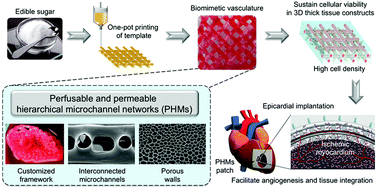3D printing of biomimetic vasculature for tissue regeneration†
Abstract
One of the pivotal factors that limits the clinical applications of tissue engineering is the inability to create complex three-dimensional (3D) tissues due to the lack of a long-range mass transport capability. Here we present a simple versatile strategy to fabricate perfusable and permeable hierarchical microchannel-networks (PHMs) via the combination of one-pot 3D printed sacrificial caramel templates and polymer coating with integrated phase separation. The patterned PHMs possess a biomimetic three level vascular structure including a custom-made scalable 3D framework, interconnected microchannels and permeable walls with controllable micropores. The fabrication process can be adapted to various polymers and integrated with diverse matrices including hydrogels, particle leached porous scaffolds, electrospun nanofibers, and bacterial cellulose. We demonstrated the power of PHMs to facilitate mass exchange in tissue engineering constructs by showing that the PHMs could maintain the metabolic functions of heart cells in vitro, facilitate in vivo angiogenesis and tissue integration, and efficiently treat myocardial infarction.

- This article is part of the themed collection: A selection of 2019 articles


 Please wait while we load your content...
Please wait while we load your content...